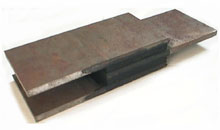 In
the conventional approach to earthquake design of building structures,
the earthquake is resisted by a combination of strength, ductility(deformibility),
and inelastic energy dissipation. Generally, the inherent damping
for these structures is low (about 1% to 5% of critical damping),
thus the energy dissipation in the elastic deformation is very small.
However the inelastic energy dissipation requires inelastic deformation
over several cycles and this invariably not only damages the structure
but also increases flexibility of the structure, and often results
in significant permanent lateral displacement of the building. In
the conventional approach to earthquake design of building structures,
the earthquake is resisted by a combination of strength, ductility(deformibility),
and inelastic energy dissipation. Generally, the inherent damping
for these structures is low (about 1% to 5% of critical damping),
thus the energy dissipation in the elastic deformation is very small.
However the inelastic energy dissipation requires inelastic deformation
over several cycles and this invariably not only damages the structure
but also increases flexibility of the structure, and often results
in significant permanent lateral displacement of the building.
By incorporating structural rubber dampers into buildings through
braces earthquake damage in buildings can be prevented. The dampers
dissipate the earthquake energy and minimize any damaging deformation
to the structure.
In the last 30 years rubber dampers have been extensively used in
wind vibration control applications. The first, and most notable of
these, was in the infamous twin towers of World Trade Center in New
York City, where 100 dampers were installed on each floor. The other
notable rubber damper applications are for 73-story Columbia Sea First
Building and the 60-story Number Two Union Square Building, both in
Seattle, USA. These rubber dampers have proved to offer a good solution
to the problem of wind-induced vibrations in tall buildings.
However, for seismic application, the damping required for the dampers
are considerably greater than those necessary to be effective for
wind vibration control. The greater severity of the earthquake loading
imposes significantly larger deformations on the dampers requiring
a very high damping compound to control the deformation. Towards this
end, MRB has developed a high damping natural rubber compound with
a loss factor of 0.4. Despite the high damping, the compound still
retain its excellent mechanical properties such as strength, fatigue
and resilience.

|




